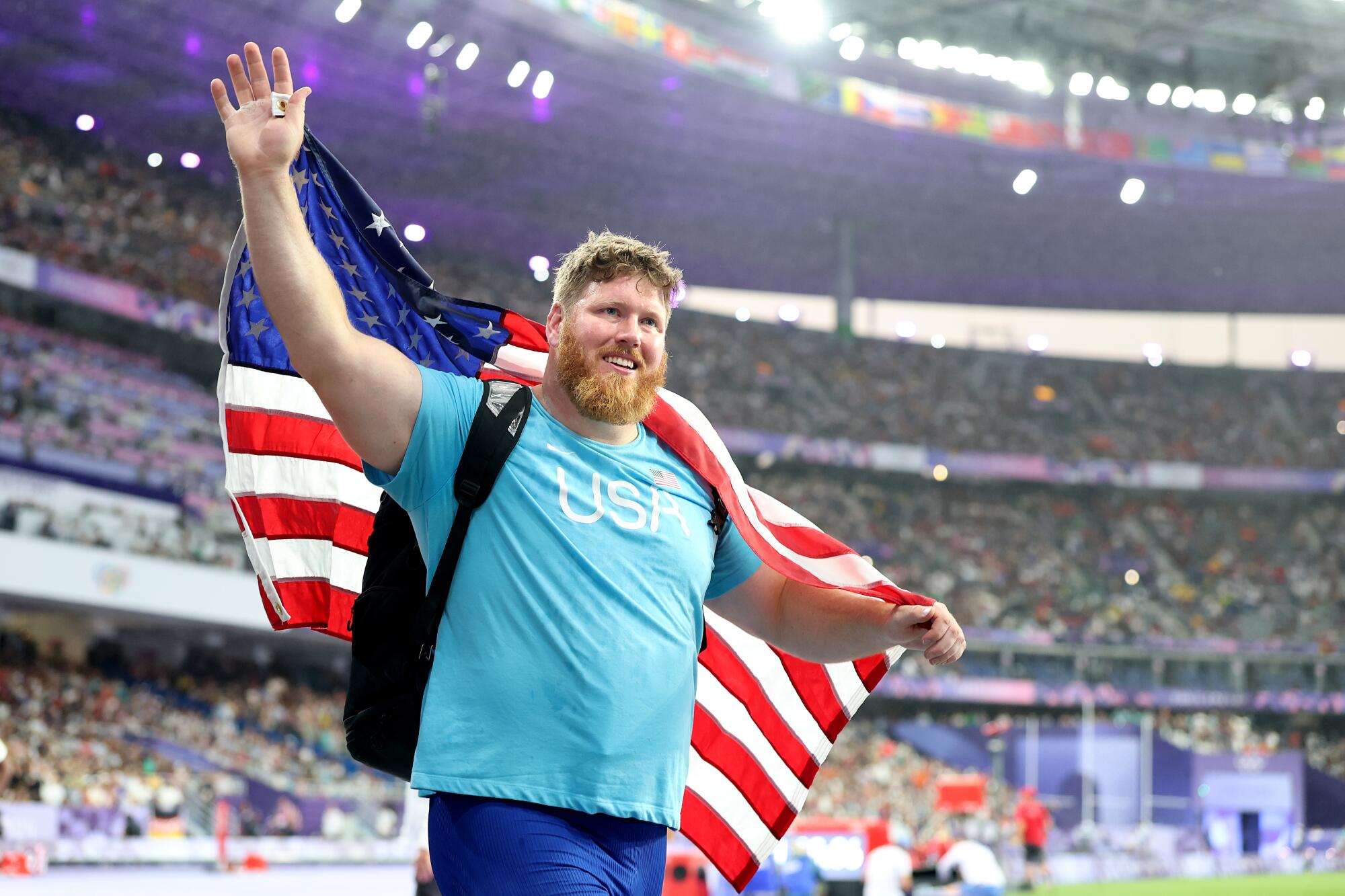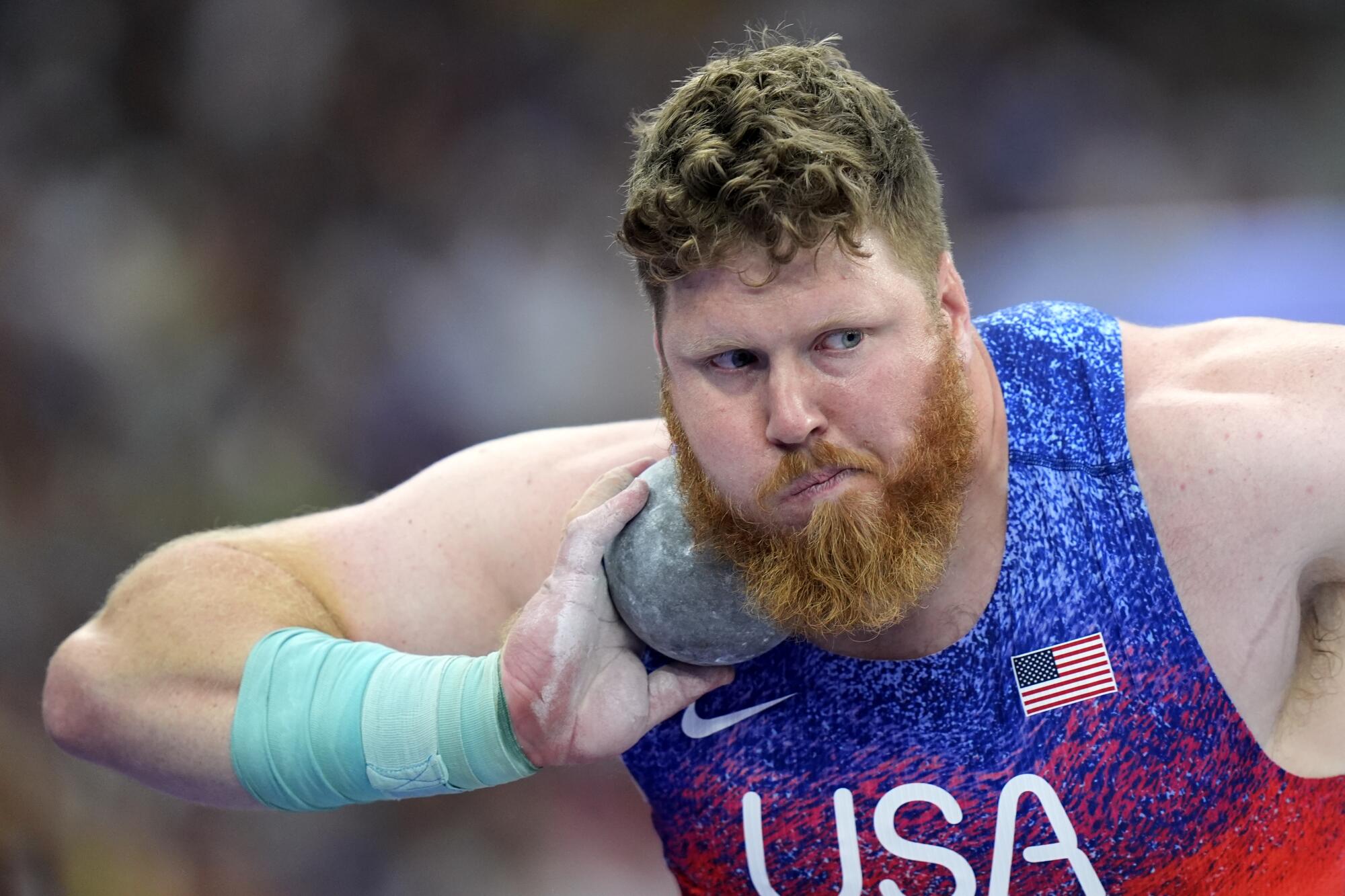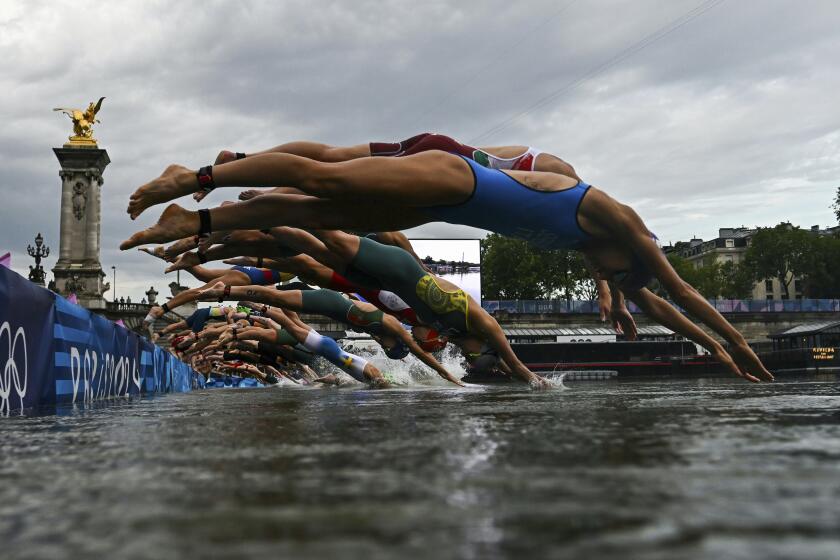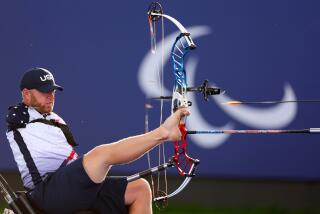
- Share via
PARIS — It sounds like the plot to a cheesy black-and-white movie from the 1940s.
A lunk of a guy goes out to the barn behind his house every night and tosses a metal ball as far as he can. Over and over. He tries shifting his feet, turning his body in different directions, tinkering.
And, just like that, he revolutionizes the sport of shot put.
But this isn’t a Hollywood story. Ryan Crouser used his innovative “Crouser Slide” to make history at the 2024 Paris Olympics this weekend, joining a select group of athletes who have dominated their event thoroughly enough to win gold at three consecutive Games.
Many of the Olympic triathletes who swam in the Seine River this week say the current was a much bigger problem than any pollution they encountered.
The 31-year-old native of Boring, Ore., called it “kind of a testament to the total dedication and hard work that has gone into it … it’s a 365-day a year job.”
With all the superstars competing here in the last few days — gymnast Simone Biles, swimmer Katie Ledecky, sprinter Noah Lyles — it might be easy to overlook Crouser. It would also be a mistake.
His story exemplifies the best aspect of the Olympics: The range of obscure and semi-obscure sports filled with athletes who devote their lives to something with no guarantee of fortune or fame.
To fully appreciate what Crouser accomplished, it helps to know more about the shot put.

The only way to heave a 16-pound ball more than 70 feet is to generate momentum by spinning your way to the release, which can be especially tricky for very large people trapped inside a seven-foot ring.
So it makes sense that, despite all their girth and grunting, shot putters tend to be science geeks.
Rather than focus on brute force, they obsess over the physics of lateral velocity, rotational radius and acceleration paths. The biomechanically optimal angle of release — 36 degrees? 38 degrees? — can be a topic for debate.
“So it’s constantly changing and evolving,” Crouser says. “Kind of under the assumption of how do we maximize potential energy creation while minimizing room for error.”

Throwing runs in his blood. His father, Mitch, was an alternate on the 1984 U.S. Olympic discus team and uncle Brian threw javelin at two Games. After excelling at shot put in high school, Crouser won four NCAA championships for the University of Texas.
His first gold at the 2016 Rio de Janeiro Games came shortly after graduation.
In a sport where many top athletes stand about 6 feet tall, Crouser uses his 6-foot-7 frame for more leverage and force on throws. But height also makes him vulnerable to committing a foul by stepping outside of that claustrophobic ring.
In his early years at the international level, he employed a fairly standard technique, working to control his body by moving precisely. In 2021, he broke Randy Barnes’ 31-year-old record with a throw of more than 76 feet at the U.S. Olympic trials, then won his second gold at the Tokyo Games.
Still, he wasn’t content.
“I feel like I experimented for a number of years just with different techniques,” he recalls. “I try to think of a rational explanation for why it would help my throw and then I’ll implement it.”

The “Fosbury Flop,” the back-roll technique made famous by Dick Fosbury at the 1968 Summer Olympics, forever changing the high jump, ranks as track’s best-known stylistic breakthrough. Though subtler, the “Crouser Slide” has been revolutionary.
Restless for something better, the self-coached Crouser searched the internet for information and applied concepts from upper-level engineering courses he took in college before switching his major to economics.
All his tinkering, spread across thousands of practice throws, led to a “light bulb moment” in that Arkansas barn in December 2022. It was about 8 p.m. and he recalls thinking “Yeah, let’s try something new just to engage myself because shot put can be extremely monotonous.”
Shotputter Ryan Crouser managed to successfully defend his title at the World Athletics Championships despite dealing with blood clots in his leg.
He focused on altering the conventional starting point, which has shot putters standing at the back of the ring, facing away from the field. Crouser shifted over to the right side of the circle, creating room to his left.
The adjustment allowed him to start his motion with a quick “slide step” to the left. It made his spin a little faster and gave his right leg more space to swing around. As he explained: “Speed is king in the shot put.”
Speed can also be unwieldy, so there were problems with consistency. But within a few months, at a springtime meet in Los Angeles, he became the first man to throw beyond 77 feet.
“It’s good for the sport,” rival Tom Walsh told reporters in his home country of New Zealand. “But we’ve got to keep our end of the bar up and keep pushing him, keep challenging him, because when someone is too dominant, the sport gets a bit dull.”
During the past 10 or so years, Crouser has amassed five of the top six — and 14 of the top 25 — throws ever.

As important as technique and mental approach can be, the shot put remains — at its core — physical and brutal.
“Throwing a 16-pound ball for a living beats you up,” Crouser said.
Doctors found two blood clots in his leg last summer. Cleared to fly at the last moment, he traveled to Budapest to defend his world championship.
Since then, a torn pectoral muscle and nagging elbow injury have forced him to adjust his practice routine. Sometimes he throws hard and takes a few days off, other times he strings together light workouts.
“I have had a bit of difficulty recognizing that I am getting older,” he says. “It makes me cherish this Olympic experience even more because I can see that I cannot do this forever.”
Heading into Saturday night’s final in Paris, it wasn’t clear if the elbow could hold up for six rounds. Rather than build his distances gradually, Crouser chased big throws early — a gamble — hoping his opponents might tighten up if they fell behind.
Throwing 74 feet 3 inches on his first attempt, he raised his arms and worked the crowd. His lead had widened by the third round, at which point nature intervened.
A storm blew in, drenching the stadium and making the shot put ring treacherously slippery. One after another, competitors started attempts only to have their feet slip and their throws fall harmlessly. U.S. teammate and longtime rival Joe Kovacs unleashed a gutty try in the final round but, for a third consecutive Olympics, finished with silver.
Speaking in the mixed zone, Crouser reflected on years of eating right, getting nine hours of sleep each night and forgoing alcohol except for a 10-day vacation at the end of each track season. He mused about winning a fourth gold at the 2028 Summer Games in Los Angeles.
If his body lasts. If he can keep thinking up improvements for his technique.
A reporter asked him about a moment from earlier in the evening. Before the finals, the shot putters emerged from a tunnel, one by one, pausing in front of a television camera. Crouser dropped to one knee in an homage to French sculpture.
His pose? The Thinker.
More to Read
Go beyond the scoreboard
Get the latest on L.A.'s teams in the daily Sports Report newsletter.
You may occasionally receive promotional content from the Los Angeles Times.









